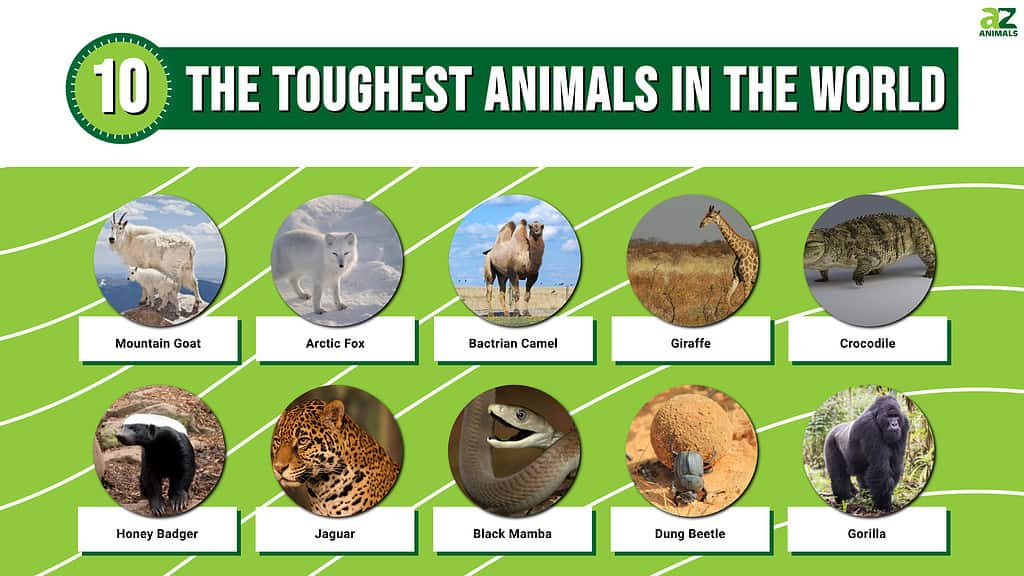
What makes an animal tough? Animals are considered tough for their ability to withstand harsh conditions or difficult situations. Often, they have a unique way of adapting that allows them to take on these challenges.
The animals on this list are considered tough for a variety of reasons – from how well they can defend themselves against larger predators to their ability to survive extreme temperatures. You may be surprised by which animals are considered the toughest creatures in the world! Discover why they made the list.
Toughest Animal for Surviving Extreme Altitudes:
Mountain Goat – Lives at Altitudes of 13,000+ Feet
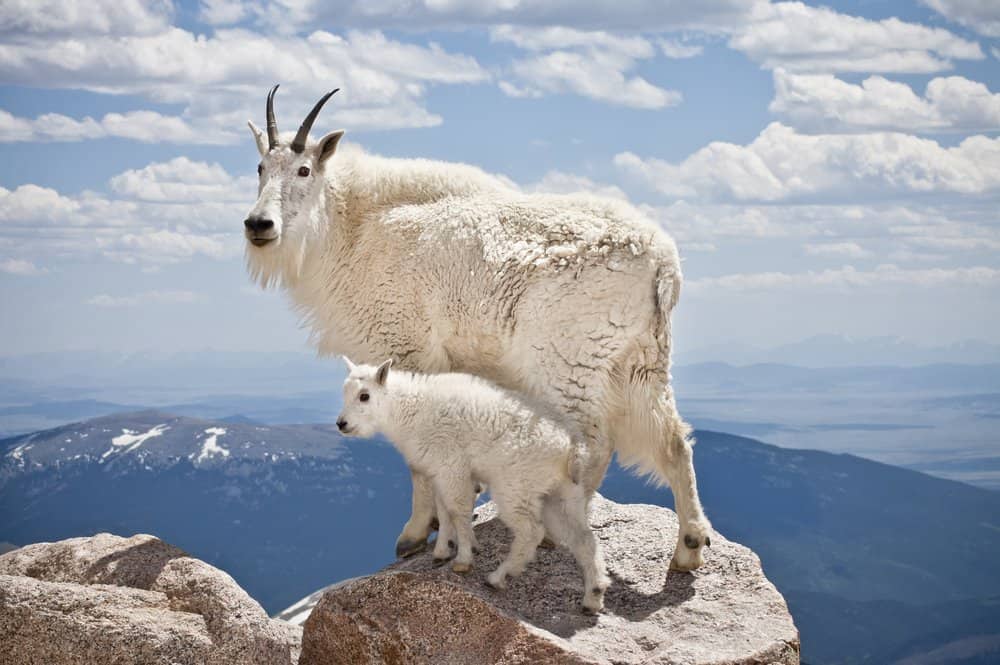
Mountain goats can survive at altitudes of over 13,000 feet.
©Joshua Schutz/Shutterstock.com
Mountain goats (Oreamnos americanus) are truly one of the toughest animals in the world and survive at extreme altitudes of over 13,000 feet. They often live in alpine regions, such as the Rocky Mountains, the Cascade Mountains, and Alaska’s Chugach Mountains.
While on those lofty heights, they snack on alpine vegetation with sedges and grasses on the menu in summer and coniferous trees and leaves in winter.
The hooves of a mountain goat have two toes that spread out giving them balance as they climb slippery, steep rocks. A rough pad on the bottom of each toe gives them traction as they climb. A mountain goat is capable of jumping 12 feet to get from one rock to another!
Mountain goats are listed as Least Concern on the IUCN Red List of Threatened Species, although they are believed to be getting smaller in size over time due to the effects of global warming.
Read more about goats, which usually have a lifespan of about as long as a dog, here.
Toughest Animal for Surviving Extreme Cold:
Arctic Fox – Can Live at 58 Degrees Below Zero

Arctic foxes live in extremely cold environments where temperatures can drop to 58 degrees below zero.
©outdoorsman/Shutterstock.com
The Arctic fox (Alopex lagopus), aka polar fox, lives on the frozen tundra of the Arctic in the northern hemisphere. This tough fox survives in an environment where temperatures drop to 58 degrees below zero and the winds can get up to 50 or 60 mph.
An Arctic fox has a bright white coat of thick fur designed to trap air, so it has a constant supply of body heat. It uses its four strong paws to create a burrow so it has a warm place to sleep.
When it’s wide awake it goes in search of dinner. Thankfully, it is by no means a fussy eater and will trail after wolves and bears hoping for a few scraps. Alternatively, it might try out some seafood, or put its excellent hearing to use, to dig out any creature which thinks itself safe in a burrow.
In summer, it stocks up on food and will eat berries, insects, or reptiles.
The conservation status of these foxes overall is Least Concern. However, specific populations in some of the Nordic countries are critically endangered.
You can find out more about the vulpine which does not bother with hibernation right here.
What other animal comes close in its ability to handle the extreme cold? The emperor penguin.
Toughest Animal for Surviving Extreme Heat:
Bactrian Camel – Lives in 100+ Degrees
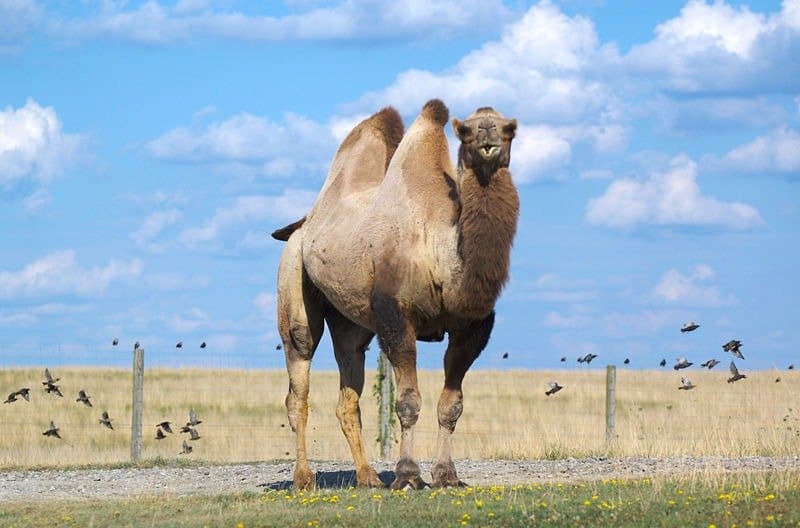
Bactrian camels live in the Gobi Desert where summer temperatures can be greater than 100 degrees.
©Jeff Kubina from Columbia, Maryland, United States., CC BY-SA 2.0, via Wikimedia Commons – License
The Bactrian camel (Camelus bactrianus) lives in the extremely hot temperatures of the Gobi Desert in Central Asia. These deserts see temperatures of more than 100 degrees in the summertime.
A Bactrian camel must drink a lot of water to stay hydrated. It can drink up to 30 gallons of water in just 13 minutes! Bactrian camels don’t release much sweat, so they can conserve water. These camels have two humps of stored fat that be converted into food and water as needed (as opposed to the dromedary camel, with only one hump). They can live for six or seven months without having to refill their water supply.
Although these woolly camelids are generally herbivores, and capable of munching on vegetation, other plant-loving creatures might give a wide birth, they are not above eating carcasses in the absence of their favorite vegetation.
As a matter of fact, they have even been known to munch on sandals and tents when feeling especially ravenous.
The conservation status of Bactrian camels is critically endangered. Their numbers are decreasing because of habitat loss due to mining and other land development.
Learn more about Bactrian camels – which are split into two species, domesticated and wild.
Toughest Animal for Surviving Without Water:
Giraffe – Can Live Up to 3 Weeks Without Drinking Water
When you think of a tough animal, a giraffe (Giraffa camelopardalis) may not be the first creature that leaps to mind. But a giraffe can survive up to three weeks without drinking water. Giraffes live in Africa on the savanna where it’s hot throughout the year. They eat moisture-filled leaves from Acacia trees which supply giraffes with most of the water they need.
Male giraffes can grow to be 18 feet tall while adult females are about 14 feet tall. It’s difficult for them to bend down to drink from a stream. When they do, they’re vulnerable to predators. So, their ability to go a long time without getting water from a stream keeps them safe. The conservation status of giraffes is vulnerable due to loss of habitat and poaching.
Read more about giraffes, which can run at 30 mph to escape predators, here.
Toughest Animal for Surviving Without Food:
Crocodile – Can Survive 3 Years Without Eating
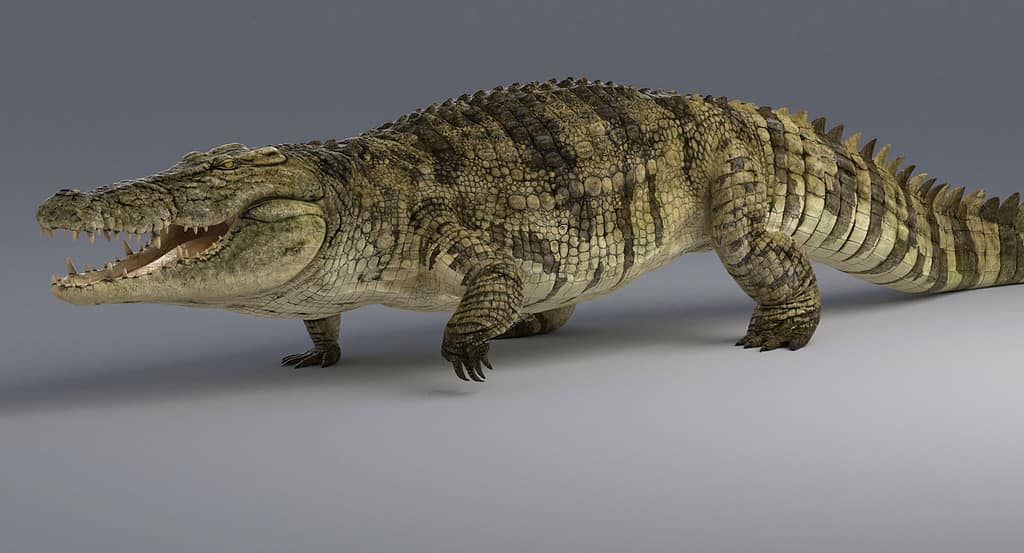
Crocodiles have slow metabolisms and can live for up to three years without eating.
©1 2 3D illustration/Shutterstock.com
Crocodiles (subfamily Crocodylinae) live in the tropical areas of Asia, Africa, North America, and Australia. Crocs are tough animals because they can survive for up to three years without eating. These reptiles have a very slow metabolism and can float for a long time without moving. In extreme cases, they seem to be able to go dormant and live off of their own tissues for long periods.
When these carnivores are hungry they eat birds, wild boar, deer, fish, and more. They grab their prey, crush it using their strong jaws, then swallow it whole.
The conservation status of the crocodile depends on its species. The American crocodile is listed as vulnerable while the saltwater crocodile is least concern.
Learn more about the semi-aquatic crocodile, which can live in freshwater, saltwater, and estuaries.
Toughest Animal for Protecting Itself:
Honey Badger – Fights Off Large Predators
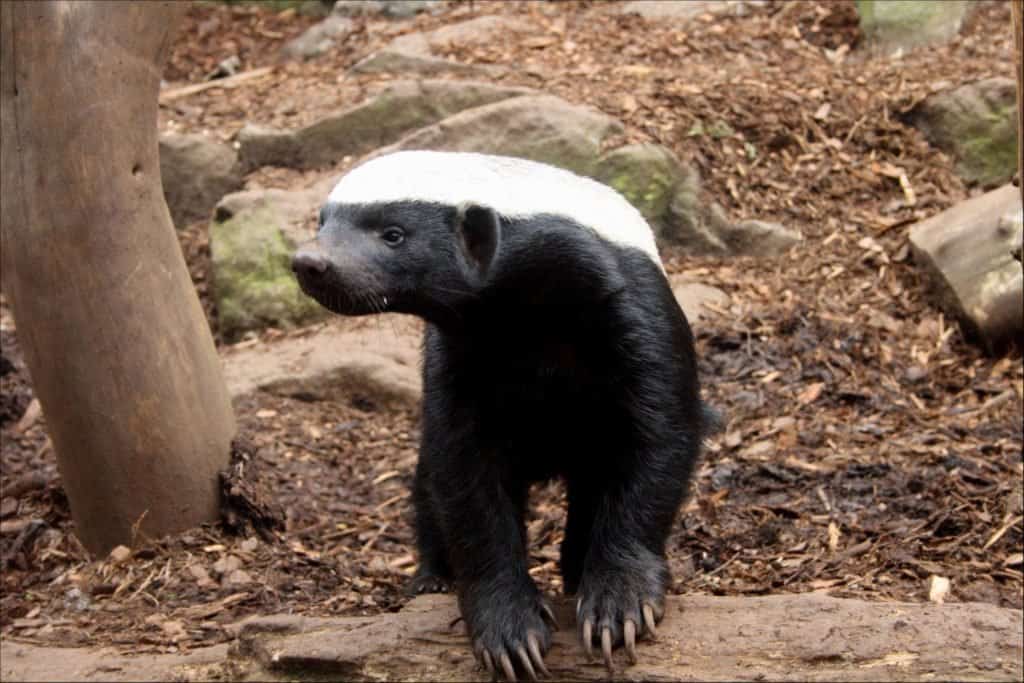
The average honey badger weighs between 13 and 30 pounds but will defend itself from much larger predators, such as lions or leopards.
©Ewan Chesser/Shutterstock.com
A honey badger (Mellivora capensis) makes the list of toughest animals because it doesn’t back down when approached by a predator – even if it’s a lion or a leopard!
A honey badger is about three feet long and weighs between 13 and 30 pounds. It has a short, sturdy body with long claws on its front feet. It uses these claws to dig holes and fight predators. This tough mammal has sharp teeth and the ability to whirl around to bite a predator that has grabbed it. Furthermore, a honey badger can release an odor powerful enough to make a predator retreat.
In spite of a fondness for honey and honey larvae, these mustelids will also eat amphibians, berries, birds, insects, and roots. They’re also not above pilfering food if the need arises and have sharp teeth and claws for tucking into meaty fare with ease.
The conservation status of honey badgers is Least Concern.
Not surprisingly, badgers are related to skunks. Find out more about badgers here.
Toughest Animal for Hunting Skills:
Jaguar – Can Pull a 500 Pound Deer into a Tree
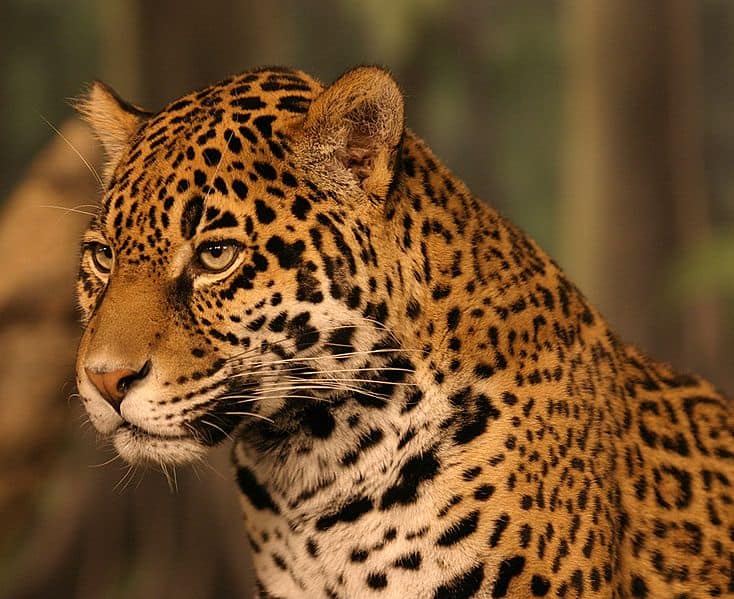
A jaguar is capable of dragging a 500 pound deer into a tree once it’s been killed.
©Cburnett at English Wikipedia, CC BY-SA 3.0, via Wikimedia Commons – License
A jaguar (Panthera onca) is not the biggest cat in the world, but it’s certainly the toughest. After capturing and killing a 500-pound deer, this cat can drag the deer’s body up a tree to have dinner on its favorite branch.
While most large cats kill their prey by biting the neck or throat, the jaguar uses its ultra-strong teeth and jaws to crush its victim’s skull. Its teeth can also penetrate a tortoise‘s shell or the thick scales of a crocodile. Jaguars also hunt prey 3 to 4 times their size such as cattle and deer.
Jaguars live in the tropical rainforests, savannas, and grasslands of South and Central America. They can grow to six feet in length and weigh up to 250 pounds.
The conservation status of jaguars is near threatened. Their population is decreasing due to the loss of habitat.
Discover more about jaguars, whose name means ‘he who kills with one leap.’
Toughest Animal for Toxicity:
Black Mamba – Venom is One of the Most Toxic on Earth
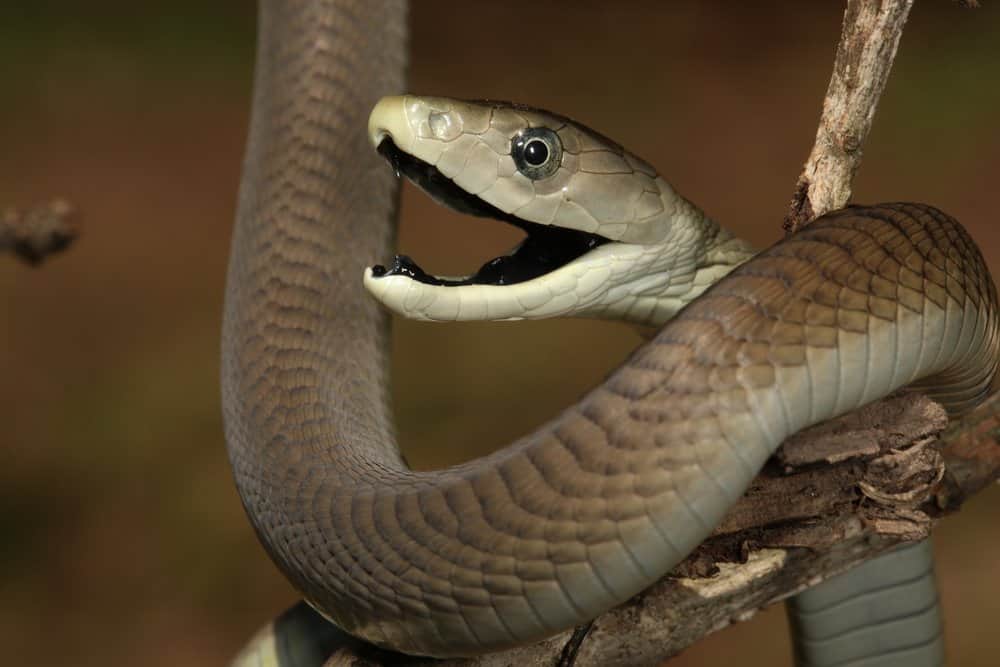
The black mamba’s venom kills a predator within 20 minutes.
©NickEvansKZN/Shutterstock.com
The Black mamba snake (Dendroaspis polylepis) makes the list of the toughest animals because of its deadly venom. It’s referred to as the world’s deadliest snake.
This snake lives in the southern and eastern parts of Africa. When attacked, a Black mamba raises a third of its body off the ground, spreads its neck hood, and opens its black mouth. If this doesn’t scare off a predator such as an owl, vulture, or mongoose, the snake will strike. However, instead of striking just once, this snake strikes many times to make sure a large amount of venom goes into its attacker. This snake’s venom kills a predator within 20 minutes.
When not frightening adversaries out of their wits, black mambas settle for a leisurely lunch which may consist of birds, mice, squirrels, or even other snakes, like the forest cobra, for example.
The conservation status of the Black mamba is Least Concern.
Learn more about snakes here, which are one of the most dangerous animals to humans.
Toughest Animal for Relative Strength:
Dung Beetle – Can Push an Object More Than 200 Times Its Weight
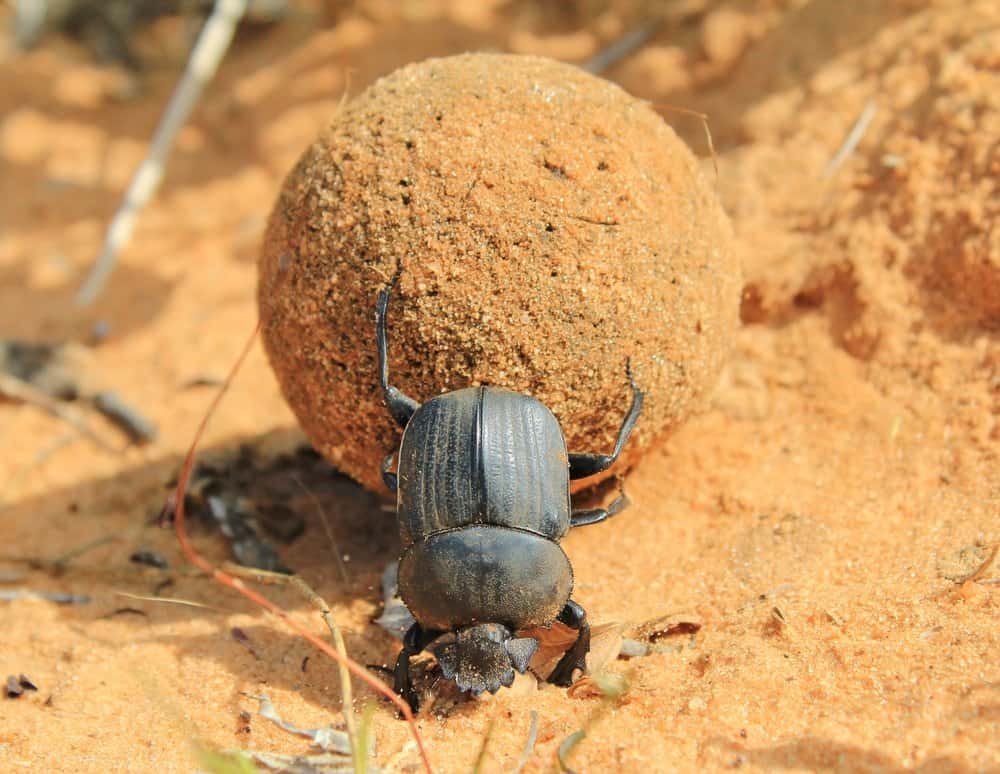
A
dung beetle
weighs less than 3.5 ounces but can push objects more than 200 times its weight.
©Stacey Ann Alberts/Shutterstock.com
A Dung beetle (Scarabaeus viettei) weighs less than 3.5 ounces and measures just three or four inches, but it can move a ball of dung (poop) that’s 200 times its own weight.
This insect lives on every continent except for Antarctica. They can survive in deserts and forests. These insects find a pile of dung, roll it to another area, and bury it, then they eat the dung or lay eggs in it.
While it may seem like a gross role to play, removing the dung of animals is important to keep land clean and free of pests. The conservation status of Dung beetles is ‘not in danger of extinction.
Read more about beetles here, which have various strengths and unique skills, here.
Toughest Animal for Brute Strength:
Gorilla – 20 Times Stronger Than a Human
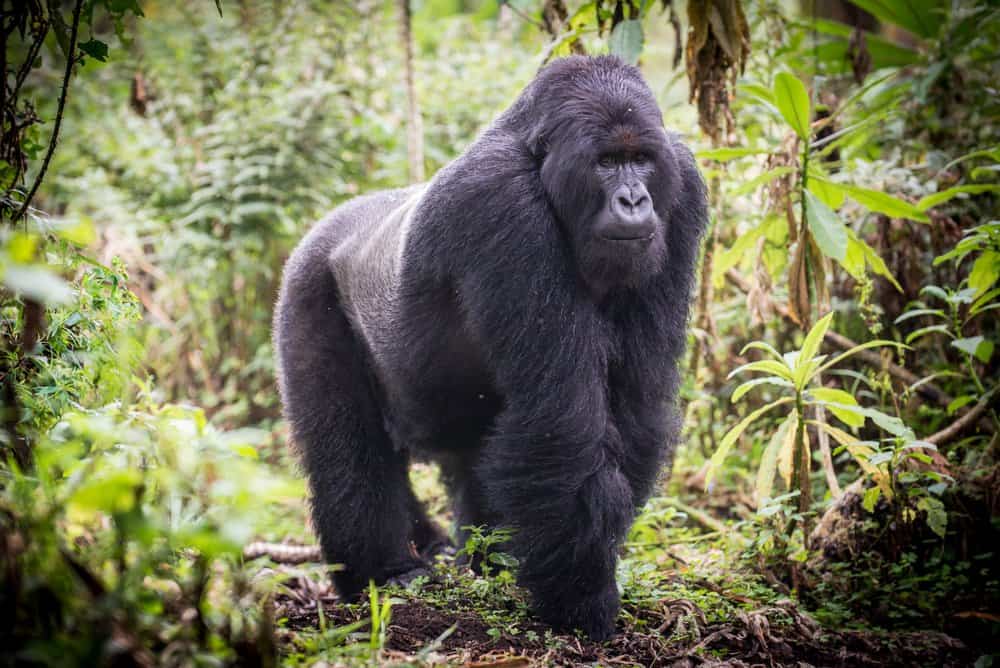
Gorillas can weigh up to 440 pounds and have 20 times the strength of an adult man.
©Jurgen Vogt/Shutterstock.com
Scientists believe gorillas (Gorilla gorilla) have 20 times the strength of an adult man. These animals can be four to six feet tall and weigh up to 440 pounds. Gorillas live in the forests of Africa, specifically the Congo Basin. They’re normally gentle animals with a preference for snacking on ants, bamboo shoots, fruits, and grubs.
However, the presence of a strange male gorilla in another’s territory is sufficient to set off that territorial switch in the latter and can result in a vicious bout between the two.
Here are some statistics you might find interesting:
- There are two distinct species of Gorillas in the world, the eastern gorillas and the western gorillas.
- There are only a little more than a thousand mountain Gorillas (a subspecies of the eastern gorillas) left in the wild today.
- The total number of eastern gorillas have dwindled to around four thousand, earning them a conservation status of endangered species.
- Humans share 98% of our DNA with the gorillas, one of the reasons they were widely used in clinical trials.
- Gorillas spent the majority of their time eating, they are herbivores and their diet consists mainly of plants.
- Sometimes they can eat snails, ants, and larvae.
- Gorillas have sixteen different types of calls that we know of.
- They are social animals and love to sleep in piles.
- Gorillas can live up to forty years in the wild.
Habitat destruction and poaching are two reasons why their numbers have fallen, but many gorillas are now protected in Africa’s national parks.
Summary Of The 10 Toughest Animals In The World
Here’s a review of 10 incredibly tough animals that shouldn’t be messed with:
| Rank | Animal | Strength/Skill |
|---|---|---|
| 1 | Mountain Goat | Surviving extreme altitude |
| 2 | Arctic Fox | Surviving extreme cold |
| 3 | Bactrian Camel | Surviving extreme heat |
| 4 | Giraffe | Surviving without water |
| 5 | Crocodile | Surviving without food |
| 6 | Honey Badger | Toughest self-defender |
| 7 | Jaguar | Hunting skills |
| 8 | Black Mamba | Strongest toxicity |
| 9 | Dung Beetle | Relative strength |
| 10 | Gorilla | Brute strength |
Bonus: King Kong, the Toughest Gorilla of All Time

King Kong can bench press an estimated 16.6 million pounds, making him the strongest animal of all time (even if he is fictitious).
©Warner Bros currently owns the rights to the 1933 version of “King Kong”, following the demise of RKO in 1959., Public domain, via Wikimedia Commons – License
Since its first appearance in 1933, the giant monster primate King Kong has entertained movie-goers for decades. King Kong has even been referred to as The Eighth Wonder of the World. A list of the King Kong movies includes:
- King Kong (1933)
- The Son of Kong (1933)
- King Kong vs Godzilla (1962)
- King Kong Escapes (1967)
- King Kong (1976) [Remake]
- King Kong Lives (1986)
- King Kong (2005) [2nd Remake]
- Kong: Skull Island (2017)
- Godzilla vs Kong (2021)
King Kong’s creator, Merian C. Cooper, saw him as a gorilla. When he was only 6 years old, he developed a fascination for gorillas after being given a book in 1899 called Explorations and Adventures in Equatorial Africa. The book documented the journeys of the French-American anthropologist, zoologist, and traveler Paul Du Chaillu to Africa. There were stories in the book of gorillas, including an exceptionally large one, which the African natives viewed as the invincible King of the African Forest. Also in the book, the author described an encounter with a gorilla as a “hellish dream creature, half man, half beast.”
As an adult, Cooper got involved in the Hollywood film industry, and set about creating what he called a “terror gorilla picture.” He created a giant gorilla who would fight with warplanes and climb the tallest building in New York–the Empire State Building. He developed the end of the movie before the entire story had been fleshed out, saying of it: “Without any conscious effort of thought I immediately saw in my mind’s eye a giant gorilla on top of the building.”
It was determined by a fan of the amazingly powerful King Kong (with superior mathematical skills) that if a normal full-grown gorilla is capable of bench pressing 4,000 pounds, then a ratio comparison to the size of King Kong would come out to him being able to bench press 16.6 million pounds! That is one strong gorilla (even if he is fictitious)!
The photo featured at the top of this post is © rokopix/Shutterstock.com
Thank you for reading! Have some feedback for us? Contact the AZ Animals editorial team.







